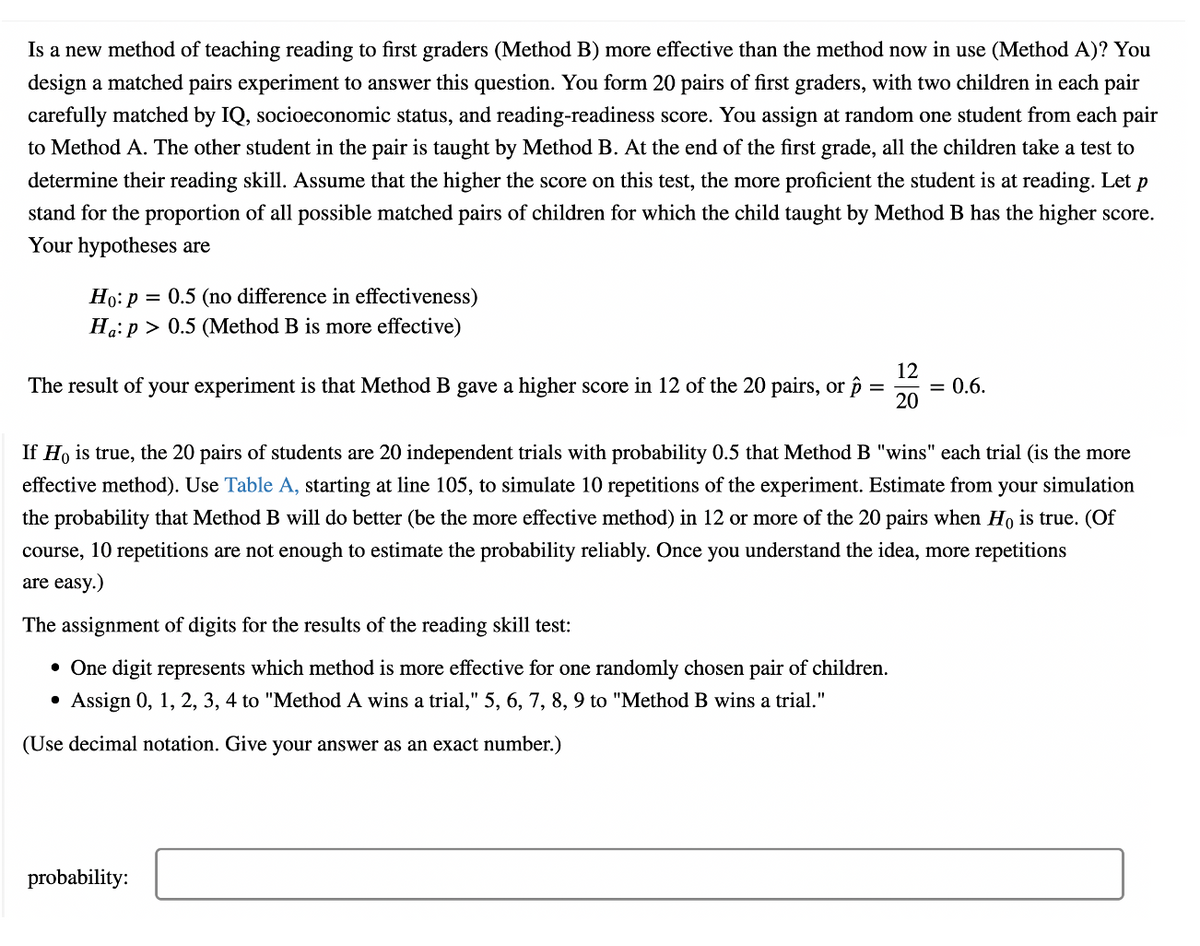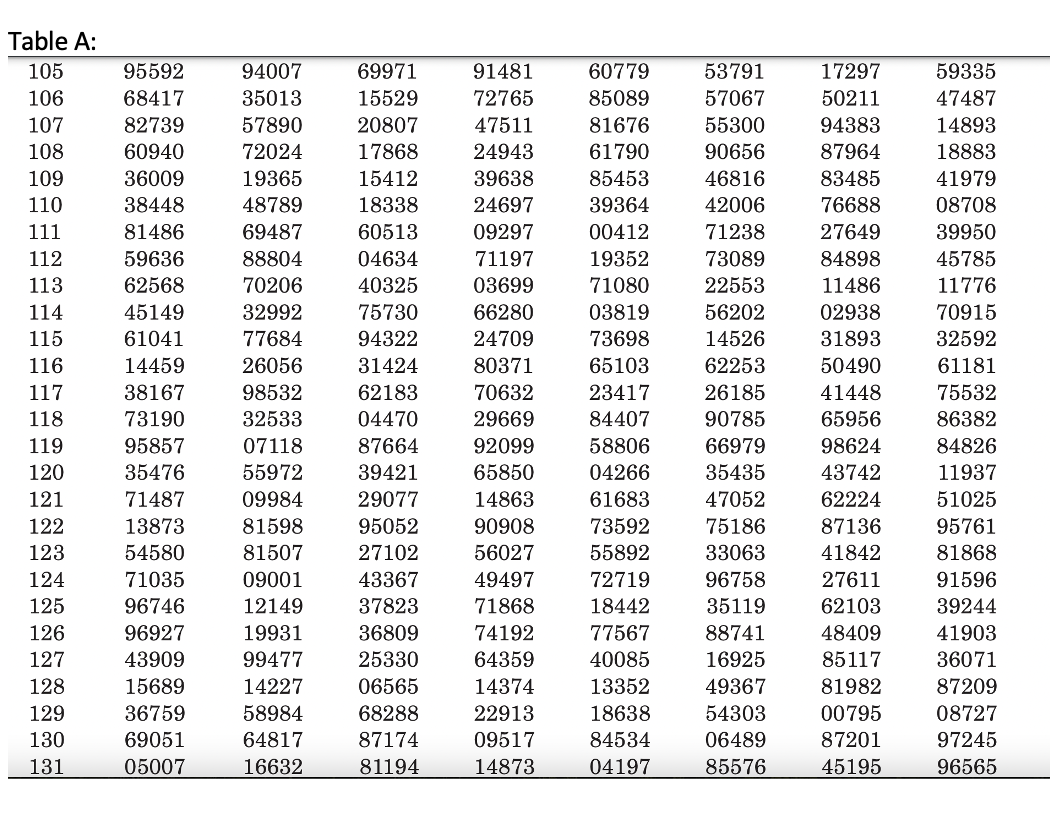Is a new method of teaching reading to first graders (Method B) more effective than the method now in use (Method A)? You design a matched pairs experiment to answer this question. You form 20 pairs of first graders, with two children in each pair carefully matched by IQ, socioeconomic status, and reading-readiness score. You assign at random one student from each pair to Method A. The other student in the pair is taught by Method B. At the end of the first grade, all the children take a test to determine their reading skill. Assume that the higher the score on this test, the more proficient the student is at reading. Let p stand for the proportion of all possible matched pairs of children for which the child taught by Method B has the higher score. Your hypotheses are Ho: p = 0.5 (no difference in effectiveness) Ha:p > 0.5 (Method B is more effective) 12 = 0.6. 20 The result of your experiment is that Method B gave a higher score in 12 of the 20 pairs, or p If Ho is true, the 20 pairs of students are 20 independent trials with probability 0.5 that Method B "wins" each trial (is the more effective method). Use Table A, starting at line 105, to simulate 10 repetitions of the experiment. Estimate from your simulation the probability that Method B will do better (be the more effective method) in 12 or more of the 20 pairs when Ho is true. (Of course, 10 repetitions are not enough to estimate the probability reliably. Once you understand the idea, more repetitions are easy.) The assignment of digits for the results of the reading skill test: • One digit represents which method is more effective for one randomly chosen pair of children. Assign 0, 1, 2, 3, 4 to "Method A wins a trial," 5, 6, 7, 8, 9 to "Method B wins a trial." (Use decimal notation. Give your answer as an exact number.) probability: Table A: 105 95592 94007 69971 91481 60779 53791 17297 59335 106 68417 35013 15529 72765 85089 57067 50211 47487 107 82739 57890 20807 47511 81676 55300 94383 14893 108 60940 72024 17868 24943 61790 90656 87964 18883 109 36009 19365 15412 39638 85453 46816 83485 41979 110 38448 48789 18338 24697 39364 42006 76688 08708 111 81486 69487 60513 09297 00412 71238 27649 39950 112 59636 88804 04634 71197 19352 73089 84898 45785 113 62568 70206 40325 03699 71080 22553 11486 11776 114 45149 32992 75730 66280 03819 56202 02938 70915 115 61041 77684 94322 24709 73698 14526 31893 32592 116 14459 26056 31424 80371 65103 62253 50490 61181 117 38167 98532 62183 70632 23417 26185 41448 75532 118 73190 32533 04470 29669 84407 90785 65956 86382 119 95857 07118 87664 92099 58806 66979 98624 84826 120 35476 55972 39421 65850 04266 35435 43742 11937 121 71487 09984 29077 14863 61683 47052 62224 51025 122 13873 81598 95052 90908 73592 75186 87136 95761 123 54580 81507 27102 56027 55892 33063 41842 81868 124 71035 09001 43367 49497 72719 96758 27611 91596 125 96746 12149 37823 71868 18442 35119 62103 39244 126 96927 19931 36809 74192 77567 88741 48409 41903 127 43909 99477 25330 64359 40085 16925 85117 36071 128 15689 14227 06565 14374 13352 49367 81982 87209 129 36759 58984 68288 22913 18638 54303 00795 08727 130 69051 64817 87174 09517 84534 06489 87201 97245 131 05007 16632 81194 14873 04197 85576 45195 96565
Is a new method of teaching reading to first graders (Method B) more effective than the method now in use (Method A)? You design a matched pairs experiment to answer this question. You form 20 pairs of first graders, with two children in each pair carefully matched by IQ, socioeconomic status, and reading-readiness score. You assign at random one student from each pair to Method A. The other student in the pair is taught by Method B. At the end of the first grade, all the children take a test to determine their reading skill. Assume that the higher the score on this test, the more proficient the student is at reading. Let p stand for the proportion of all possible matched pairs of children for which the child taught by Method B has the higher score. Your hypotheses are Ho: p = 0.5 (no difference in effectiveness) Ha:p > 0.5 (Method B is more effective) 12 = 0.6. 20 The result of your experiment is that Method B gave a higher score in 12 of the 20 pairs, or p If Ho is true, the 20 pairs of students are 20 independent trials with probability 0.5 that Method B "wins" each trial (is the more effective method). Use Table A, starting at line 105, to simulate 10 repetitions of the experiment. Estimate from your simulation the probability that Method B will do better (be the more effective method) in 12 or more of the 20 pairs when Ho is true. (Of course, 10 repetitions are not enough to estimate the probability reliably. Once you understand the idea, more repetitions are easy.) The assignment of digits for the results of the reading skill test: • One digit represents which method is more effective for one randomly chosen pair of children. Assign 0, 1, 2, 3, 4 to "Method A wins a trial," 5, 6, 7, 8, 9 to "Method B wins a trial." (Use decimal notation. Give your answer as an exact number.) probability: Table A: 105 95592 94007 69971 91481 60779 53791 17297 59335 106 68417 35013 15529 72765 85089 57067 50211 47487 107 82739 57890 20807 47511 81676 55300 94383 14893 108 60940 72024 17868 24943 61790 90656 87964 18883 109 36009 19365 15412 39638 85453 46816 83485 41979 110 38448 48789 18338 24697 39364 42006 76688 08708 111 81486 69487 60513 09297 00412 71238 27649 39950 112 59636 88804 04634 71197 19352 73089 84898 45785 113 62568 70206 40325 03699 71080 22553 11486 11776 114 45149 32992 75730 66280 03819 56202 02938 70915 115 61041 77684 94322 24709 73698 14526 31893 32592 116 14459 26056 31424 80371 65103 62253 50490 61181 117 38167 98532 62183 70632 23417 26185 41448 75532 118 73190 32533 04470 29669 84407 90785 65956 86382 119 95857 07118 87664 92099 58806 66979 98624 84826 120 35476 55972 39421 65850 04266 35435 43742 11937 121 71487 09984 29077 14863 61683 47052 62224 51025 122 13873 81598 95052 90908 73592 75186 87136 95761 123 54580 81507 27102 56027 55892 33063 41842 81868 124 71035 09001 43367 49497 72719 96758 27611 91596 125 96746 12149 37823 71868 18442 35119 62103 39244 126 96927 19931 36809 74192 77567 88741 48409 41903 127 43909 99477 25330 64359 40085 16925 85117 36071 128 15689 14227 06565 14374 13352 49367 81982 87209 129 36759 58984 68288 22913 18638 54303 00795 08727 130 69051 64817 87174 09517 84534 06489 87201 97245 131 05007 16632 81194 14873 04197 85576 45195 96565
Holt Mcdougal Larson Pre-algebra: Student Edition 2012
1st Edition
ISBN:9780547587776
Author:HOLT MCDOUGAL
Publisher:HOLT MCDOUGAL
Chapter11: Data Analysis And Probability
Section: Chapter Questions
Problem 8CR
Related questions
Question

Transcribed Image Text:Is a new method of teaching reading to first graders (Method B) more effective than the method now in use (Method A)? You
design a matched pairs experiment to answer this question. You form 20 pairs of first graders, with two children in each pair
carefully matched by IQ, socioeconomic status, and reading-readiness score. You assign at random one student from each pair
to Method A. The other student in the pair is taught by Method B. At the end of the first grade, all the children take a test to
determine their reading skill. Assume that the higher the score on this test, the more proficient the student is at reading. Let p
stand for the proportion of all possible matched pairs of children for which the child taught by Method B has the higher score.
Your hypotheses are
Ho: p = 0.5 (no difference in effectiveness)
Ha:p > 0.5 (Method B is more effective)
12
= 0.6.
20
The result of your experiment is that Method B gave a higher score in 12 of the 20 pairs, or p
If Ho is true, the 20 pairs of students are 20 independent trials with probability 0.5 that Method B "wins" each trial (is the more
effective method). Use Table A, starting at line 105, to simulate 10 repetitions of the experiment. Estimate from
your
simulation
the probability that Method B will do better (be the more effective method) in 12 or more of the 20 pairs when Ho is true. (Of
course, 10 repetitions are not enough to estimate the probability reliably. Once you understand the idea, more repetitions
are easy.)
The assignment of digits for the results of the reading skill test:
• One digit represents which method is more effective for one randomly chosen pair of children.
Assign 0, 1, 2, 3, 4 to "Method A wins a trial," 5, 6, 7, 8, 9 to "Method B wins a trial."
(Use decimal notation. Give your answer as an exact number.)
probability:

Transcribed Image Text:Table A:
105
95592
94007
69971
91481
60779
53791
17297
59335
106
68417
35013
15529
72765
85089
57067
50211
47487
107
82739
57890
20807
47511
81676
55300
94383
14893
108
60940
72024
17868
24943
61790
90656
87964
18883
109
36009
19365
15412
39638
85453
46816
83485
41979
110
38448
48789
18338
24697
39364
42006
76688
08708
111
81486
69487
60513
09297
00412
71238
27649
39950
112
59636
88804
04634
71197
19352
73089
84898
45785
113
62568
70206
40325
03699
71080
22553
11486
11776
114
45149
32992
75730
66280
03819
56202
02938
70915
115
61041
77684
94322
24709
73698
14526
31893
32592
116
14459
26056
31424
80371
65103
62253
50490
61181
117
38167
98532
62183
70632
23417
26185
41448
75532
118
73190
32533
04470
29669
84407
90785
65956
86382
119
95857
07118
87664
92099
58806
66979
98624
84826
120
35476
55972
39421
65850
04266
35435
43742
11937
121
71487
09984
29077
14863
61683
47052
62224
51025
122
13873
81598
95052
90908
73592
75186
87136
95761
123
54580
81507
27102
56027
55892
33063
41842
81868
124
71035
09001
43367
49497
72719
96758
27611
91596
125
96746
12149
37823
71868
18442
35119
62103
39244
126
96927
19931
36809
74192
77567
88741
48409
41903
127
43909
99477
25330
64359
40085
16925
85117
36071
128
15689
14227
06565
14374
13352
49367
81982
87209
129
36759
58984
68288
22913
18638
54303
00795
08727
130
69051
64817
87174
09517
84534
06489
87201
97245
131
05007
16632
81194
14873
04197
85576
45195
96565
Expert Solution
This question has been solved!
Explore an expertly crafted, step-by-step solution for a thorough understanding of key concepts.
This is a popular solution!
Trending now
This is a popular solution!
Step by step
Solved in 3 steps with 5 images

Recommended textbooks for you

Holt Mcdougal Larson Pre-algebra: Student Edition…
Algebra
ISBN:
9780547587776
Author:
HOLT MCDOUGAL
Publisher:
HOLT MCDOUGAL

College Algebra
Algebra
ISBN:
9781305115545
Author:
James Stewart, Lothar Redlin, Saleem Watson
Publisher:
Cengage Learning

College Algebra (MindTap Course List)
Algebra
ISBN:
9781305652231
Author:
R. David Gustafson, Jeff Hughes
Publisher:
Cengage Learning

Holt Mcdougal Larson Pre-algebra: Student Edition…
Algebra
ISBN:
9780547587776
Author:
HOLT MCDOUGAL
Publisher:
HOLT MCDOUGAL

College Algebra
Algebra
ISBN:
9781305115545
Author:
James Stewart, Lothar Redlin, Saleem Watson
Publisher:
Cengage Learning

College Algebra (MindTap Course List)
Algebra
ISBN:
9781305652231
Author:
R. David Gustafson, Jeff Hughes
Publisher:
Cengage Learning